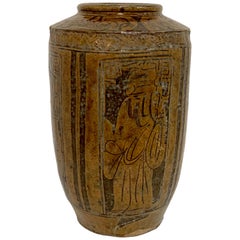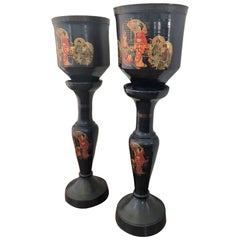Terracotta Ceramics
1
71
to
5
51
15
71
71
71
30
8
33
19
5
1
2
1
3,982
4,596
2,621
897
332
66
53
51
8
3
Material: Terracotta
Petit Chinese Ming Dynasty 17th Century Terracotta Granary with Verdigris Patina
Located in Yonkers, NY
A 17th century Chinese Ming Dynasty granary hand made from terracotta with a verde-gris patina. This miniature of a traditional Chinese granary features a conical top and rests on th...
Category
17th Century Chinese Ming Antique Terracotta Ceramics
Materials
Terracotta
Pair of 20th Century Italian Terracotta Fu Dogs
Located in Houston, TX
A fabulous large pair of Italian terracotta Fu dogs. The opposing pair are ornately handmade and hand painted with vibrant jewel tones.
Category
20th Century Italian Ming Terracotta Ceramics
Materials
Terracotta
Chinese Storage Jar
Located in Palm Springs, CA
An early 20th century Chinese salt glazed terracotta storage jar. It depicts figures on 4 sides, please see the detailed photographs. In age appropriate co...
Category
Early 20th Century Chinese Terracotta Ceramics
Materials
Terracotta
Petite Chinese Ming Dynasty Period Glazed Table with Polychrome Finish
Located in Yonkers, NY
A petite Chinese Ming Dynasty glazed table from the 15th or 16th century with polychrome finish. Crafted in China during the prestigious Ming Dynasty, this petite table charms us wit...
Category
16th Century Chinese Ming Antique Terracotta Ceramics
Materials
Terracotta
Pair of Large Chinoiserie Style Urns or Vases on Pedestals of Glazed Terracotta
Located in Miami, FL
Pair of large chinoiserie style urns or vases on pedestals of glazed terracotta
Measurements:
Item A:
Pedestal: H 31.29 in, D 12.99 in, W 13.38 in
Total height with vase 45.66 ...
Category
Early 20th Century Asian Chinoiserie Terracotta Ceramics
Materials
Terracotta
Impressive Terracotta Funerary Procession - Ming Dynasty, China '1368-1644 AD'
Located in San Pedro Garza Garcia, Nuevo Leon
Impressive Funeral Ensamble of 10 Terracotta Glazed Figures in green and caramel colors depicting a votive procession with a palanquin, his four carriers, a horse, a stableman, two musicians, and an offering carrier.
This ensemble is accompanied by a Certificate of Authenticity, and Certificate of Expertise by Jean-Yves Nathan - Specialist in Asian Arts for the CEDEA (The European Confederation of Art Experts).
Burial figurines of graceful dancers, mystical beasts, and everyday objects reveal both how people in early China approached death and how they lived. Since people viewed the afterlife as an extension of worldly life, these figurines, called mingqi, sometimes referred as “spirit utensils” or “vessels of ghosts” disclose details of routine existence and provide insights into belief systems over a thousand-year period.
The Ming dynasty was the ruling dynasty of China – then known as the Empire of the Great Ming – for 276 years (1368–1644 AD). Founded by Chu Yuan-chang, the rebel leader that was successful in removing the mongols from the throne. Chinese control was re-asserted in China and eastern Asia. Literature became more important, schools were created, and the justice system was reformed. The Ming dynasty is described by some as "one of the greatest eras of orderly government and social stability in human history,” was the last imperial dynasty in China ruled by ethnic Han Chinese.
The practice of burying ceramic objects with the deceased went into decline from the 10th to the 14th Century AD. There was a revival in placing miniature representations of glazed terracotta objects such a furniture, food offerings, horses, miniature statues...
Category
15th Century and Earlier Chinese Ming Antique Terracotta Ceramics
Materials
Terracotta
Superb Set of 5 Elegant Court Attendants, Ming Dynasty, 1368-1644 AD TL Tested
Located in San Pedro Garza Garcia, Nuevo Leon
A stunning set of 5 graceful terracotta figurines from the Ming Dynasty '1368-1644' AD. These elegant attendants are standing on a yellow glazed lotus flower over a high hexagonal green plinth and wear fine robes in matching green and yellow glazes. The unglazed areas have pigmented colors in red, black and white. Each is carrying essential offerings for the royal family. The head is detachable as often seen on the larger figures from this period. Meticulously detailed facial expressions have been hand-painted.
Condition: Mint, finely preserved glaze and pigment, undamaged and no repairs.
Provenance: Ex. Danish Collection.
This set is guaranteed authentic and comes with a Certificate of Authenticity and TL Test from Laboratory Kotalla in Germany (The Oldest Thermoluminescence Testing Laboratory in the World).
Dimensions: Average 54 H cms
Burial figurines of graceful dancers, mystical beasts, and everyday objects reveal both how people in early China approached death and how they lived. Since people viewed the afterlife as an extension of worldly life, these figurines, called mingqi, sometimes referred as “spirit utensils” or “vessels of ghosts” disclose details of routine existence and provide insights into belief systems over a thousand-year period.
The Ming dynasty was the ruling dynasty of China – then known as the Empire of the Great Ming – for 276 years (1368–1644 AD). Founded by Chu Yuan-chang, the rebel leader that was successful in removing the mongols from the throne. Chinese control was re-asserted in China and eastern Asia. Literature became more important, schools were created, and the justice system was reformed. The Ming dynasty is described by some as "one of the greatest eras of orderly government and social stability in human history,” was the last imperial dynasty in China ruled by ethnic Han Chinese.
The practice of burying ceramic objects with the deceased went into decline from the 10th to the 14th Century AD. There was a revival in placing miniature representations of glazed terracotta objects such a furniture, food offerings, horses, miniature statues...
Category
15th Century and Earlier Chinese Ming Antique Terracotta Ceramics
Materials
Terracotta
Terracotta Chef Figure in Han Style
Located in Somis, CA
A fantastic Han style terracotta figure. Such a figure is seen in the Han dynasty dating 206 BC-220 AD. This piece is one of the oldest pieces among our collections. He appears to be...
Category
20th Century Chinese Han Terracotta Ceramics
Materials
Terracotta, Pottery
Han Dynasty Standing Horse Trainer “Palafrenieri”
Located in San Pedro Garza Garcia, Nuevo Leon
Huge hollow molded terracotta, standing male figure wearing a hip-length multi-layered robe with a collared neck. Implements suspended from his waist, holding a staff in his right ha...
Category
15th Century and Earlier Han Antique Terracotta Ceramics
Materials
Terracotta
Japanese Head of Female Haniwa
Located in New York, NY
A Japanese Haniwa depicting the head of a young woman in unglazed terracotta, produced 3rd to 4th century AD, during the Kofun or Tumulus period (c. AD...
Category
15th Century and Earlier Japanese Antique Terracotta Ceramics
Materials
Terracotta
Indonesian Large Terracotta Water Jar, Indonesia late 19th century
Located in Utrecht, NL
As a country with rich cultural heritage, handicrafts produced in Indonesia also display a high level of diversity. Each province, even each production centre has its own speciality and uniqueness. Following the nation’s motto of “Unity in Diversity” (“Bhinneka Tunggal Ika”), the diversity of Indonesian handicrafts is united by a single underlying characteristic: uniquely beautiful items that epitomize the beauty of nature.
This water jar possesses an elemental, organic power that comes from its rich historical origin, earthly palette and materials. Pottery made of earth and water elements becomes extraordinary because it has passed through various times, and carries a layer of each phase of its life. The shape and decorative elements of this jar is distinctively Indonesian, with a handcrafted asymmetric shape, terracotta colour and subtle rings running around the body. Earthenware is one of the most commonly used ceramics...
Category
Late 19th Century Indonesian Tribal Antique Terracotta Ceramics
Materials
Terracotta
Chinese Drip Glaze Kitchen Jar, circa 1900
Located in Chicago, IL
A captivating textured glaze coats the simple, slightly-tapered form of this Qing-dynasty kitchen jar. Drip patterns and firing imperfections give the jar fantastic character, castin...
Category
Early 20th Century Chinese Qing Terracotta Ceramics
Materials
Terracotta
Midnight Glazed Kitchen Jar, circa 1900
Located in Chicago, IL
A dark blue-black glaze coats the body of this small kitchen jar, sheeting down the sides and pooling at the sharp angle drawn by its high shoulders. The glazed vessel dates to the e...
Category
Early 20th Century Chinese Qing Terracotta Ceramics
Materials
Terracotta
Recently Viewed
View AllMore Ways To Browse
Japanese Antique Market
Asian P
Yellow Chinese Export
Qing 20th Century Porcelain
Japanese Yellow Porcelain
Arita Blue White
Japanese Plum
Chinese Export Butterfly
17th Century Blue And White China
Chinese Porcelain Seat
Asian Large Blue Vases
Porcelain Phoenix
Qing Dynasty Blue And White
Japanes 19th Century Satsuma
Japanese Imari Sets
Chinese Famille Verte
White Porcelain Dragon
Chinese Ruyi





